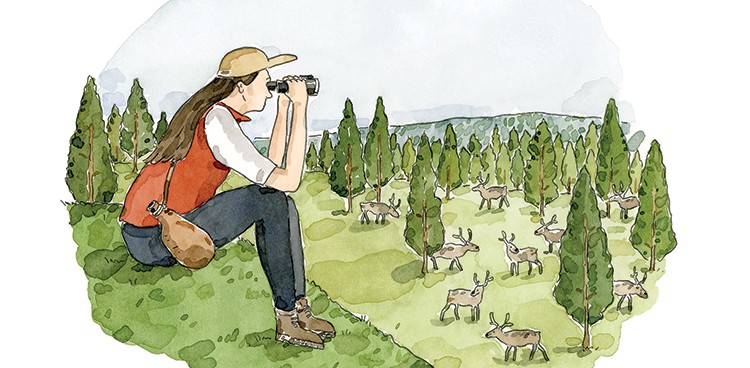
Catching a reindeer is no easy task—nor is gripping one by its furry antlers. Just a few more minutes, I thought, struggling to hold on while Lotta Svensson, my guide, milked furiously.
The midday summer sun beat down on us, and I looked around the forest to see hundreds of reindeer strolling nearby. I wondered how I’d landed here, doing this, somewhere in the Arctic Circle. But then Lotta stood up, and my mind wandered back. She handed me a small wooden gourd of fresh milk, and I released my reindeer. Mission accomplished.
Hours earlier Lotta had asked me the same thing: How did you get here? I wanted to tell her the short version, that I’d taken a bus from Umeå, Sweden, as soon as the National Swedish Sami Association informed me that she was among the last people to still make reindeer cheese. But as Lotta looked me over, I admitted the long version: A month earlier I’d boarded a plane to Alta, Norway, after visiting a museum where I learned that reindeer cheese was on the verge of extinction. Between knocking on herders’ doors, calling dozens of cheese counters and tourist centers, and meeting with Sami Parliament officials, I’d traveled more than one thousand miles by bus and on foot to find the cheese before it vanishes.
Reindeer cheese offers a rare glimpse at nomadic dairy practices. Traditionally made by Sami, the indigenous people of northern Norway, Sweden, Finland, and Russia, it provided sustenance to herders during their long migrations across the Arctic. Cheese crafted from the milk of these wild deer recalls times past, when it was made out of necessity.
While the make process varies widely across Lapland (sometimes the curd is cooked; other times it’s smoked), Lotta produces cheese as her ancestors did, by hand and in small batches, without modern conveniences such as electricity, thermometers, freeze-dried cultures, or store-bought rennet. That afternoon in the forest, Lotta pointed out wild thistles and explained her process: After adding these thistles to fresh milk, she leaves it to coagulate overnight. Come morning, she separates curds from whey and hangs them in fist-size bags to drain.
I never had the chance to taste reindeer cheese, but I sipped the warm milk Lotta gave me and was surprised by its rich, buttery taste. With an average butterfat content of 22.5 percent—six times that of the average cow’s milk—it seems the ideal drink in a region where body fat is needed for insulation against the cold.
Growing up in Vermont, a part of the world that has no reindeer (apart from Santa’s steeds), I assumed Lotta had to milk regularly. But she confessed otherwise—she only milks sporadically and did so especially for me. Herders historically made cheese to ensure their survival throughout long, sunless winters, but now most Sami live in permanent homes, drive cars, and send their kids to public school. As life has gotten easier, it’s hardly surprising that they now prefer to buy milk in supermarkets.
Whether or not something is lost if reindeer cheesemaking ceases with Lotta is debatable. To a certain extent, cheese production around the world has always evolved with industrial revolutions, new technologies, and trade deals. Many wheels and wedges have disappeared or become distant versions of what they once were, unable to adapt to market demands, consumer tastes, or price points.
Yet as cheesemaking is increasingly homogenized and dominated by large, multi-national corporations, reindeer cheese—and Lotta’s story—offers an alternative narrative and reminds us that cheese production was once about survival and creatively using any and all available resources. The National Swedish Sami Association believes reindeer cheese is worth saving. When I interviewed the association’s project coordinator, Totte Nordahl, he was working on marketing the cheese to tourists and incentivizing herders to keep producing it. If Sami cheese disappears, he said, so does an ancient knowledge.
Before departing Lapland, I asked Lotta why she makes cheese. Her sole driver is to safeguard the tradition for the next generation. Tourism could help, she added, but either way, it seems she’s determined to carry on.
Feature Artwork Illustrated by Tom Bingham



